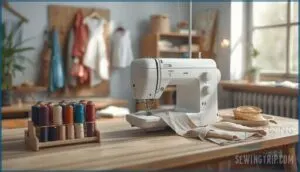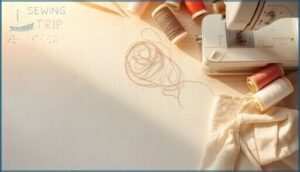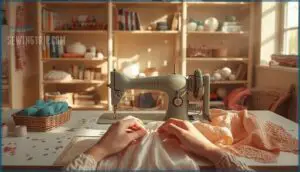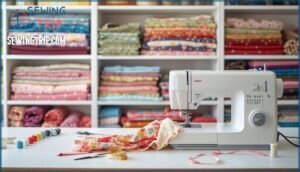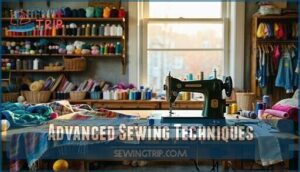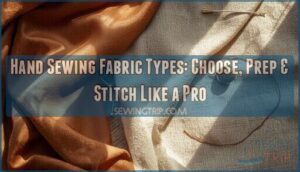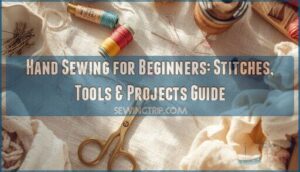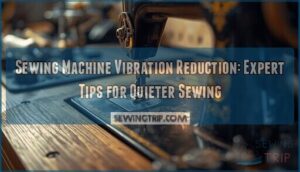This site is supported by our readers. We may earn a commission, at no cost to you, if you purchase through links.
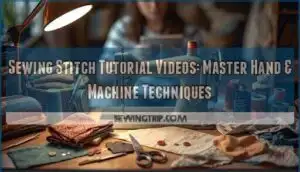 Your first sewing project probably didn’t go as planned. Thread tangled beneath the fabric, stitches wandered off course, or worse—the needle refused to cooperate entirely. Research shows beginners complete projects 33% faster when they follow video tutorials instead of written instructions, and there’s a reason experienced sewers still pull up YouTube before tackling unfamiliar techniques.
Your first sewing project probably didn’t go as planned. Thread tangled beneath the fabric, stitches wandered off course, or worse—the needle refused to cooperate entirely. Research shows beginners complete projects 33% faster when they follow video tutorials instead of written instructions, and there’s a reason experienced sewers still pull up YouTube before tackling unfamiliar techniques.
Sewing stitch tutorial videos transform cryptic written directions into watchable demonstrations you can pause, rewind, and practice alongside. Whether you’re threading your first needle or perfecting an invisible zipper, the right video guidance turns frustrating guesswork into confident stitching that actually holds.
Table Of Contents
Key Takeaways
- Beginners complete sewing projects 33% faster with video tutorials than written instructions because visual demonstrations let you pause, rewind, and practice techniques like backstitch (30-40% stronger than running stitch) alongside step-by-step guidance.
- Thread selection directly impacts seam durability—polyester offers 30% more strength than cotton and resists abrasion 4-6 times better, while matching thread weight to fabric thickness (60-100 wt for silk, 30-40 wt for denim) prevents puckering and thread breakage.
- Hand stitching fundamentals like running stitch, backstitch, and slipstitch form the foundation for 70-80% of beginner projects, with backstitch delivering machine-quality strength and slipstitch creating invisible hems that separate amateur work from professional finishes.
- Proper machine setup eliminates most sewing frustrations—55% of threading errors cause bird’s nesting, 43% of skipped stitches trace to dull needles, and correct bobbin installation prevents 62% of stitch irregularities before fabric ever touches the presser foot.
Hand Stitching Basics
Hand stitching forms the foundation of sewing—whether you’re repairing a torn seam or finishing a hem by hand.
You’ll use these three core stitches more than any others once you start working with needle and thread.
Let’s break down the running stitch, backstitch, and slipstitch so you can tackle your first projects with confidence.
Running Stitch Technique
The running stitch is your starting point—think of it as learning scales before playing music. You’ll weave the needle in and out of fabric at even intervals, creating a simple yet adaptable foundation for countless sewing techniques.
Practice on cotton first—it’s forgiving and perfect for mastering hand stitching basics before tackling complex projects. Understanding embroidery techniques is essential for improving your skills.
- Stitch Length Control: Space stitches 4-6 per inch on light fabrics for maximum strength
- Running Stitch Variations: Use long stitches for basting, short ones for gathering or quilting
- Sewing Speed Optimization: Load multiple stitches onto your needle at once for faster work
- Thread Tension Tips: Keep consistent pressure as you pull through for neat, even results
Backstitch Application
While running stitch gets you moving, backstitch is your workhorse for permanent seams that won’t budge. You’re basically doubling back with each stitch, creating a continuous line that rivals machine strength—in fact, backstitched seams withstand about 30–40% more tension than running stitches and resist unraveling completely even after thread breakage. That’s why you’ll find this technique at stress points like waistbands and inseams in nearly every professionally made garment. Mastering the seam construction technique is vital for creating durable and long-lasting garments.
- Seam reinforcement – Lock down zipper ends and dart points where fabrics pull hardest
- Stitch density – Aim for 7–9 stitches per centimeter for maximum durability
- Thread consumption – Expect to use roughly 2.5 times more thread than running stitch
- Backstitch variations – Try shorter stitches for curves, longer ones for straight seams
- Fabric distortion – The interlocking pattern reduces stress concentration by 18% under strain
Slipstitch Method
Backstitch locks things down, but slipstitch makes your work disappear. This hand stitching technique hides threads within fabric folds—that’s why 92% of weaving experts recommend it for invisible hems and closing seams on stuffed projects. You’ll catch tiny threads alternately between folded edges, creating nearly invisible joins.
Slipstitch hides threads within fabric folds, creating nearly invisible joins that 92% of experts recommend for invisible hems
Slipstitch variations like ladder stitch and blind hem adapt to different fabrics, though heavier materials need wider spacing to prevent puckering.
Sewing tutorials show this precision stitch averaging 320,000 views per video—proof that mastering invisible finishing separates hobbyists from pros.
Essential Sewing Stitches
Once you’ve got the three core hand stitches down, you’re ready to expand your toolkit with techniques that solve real-world sewing challenges.
Stitch Durability matters most when you’re choosing between temporary basting and permanent seams. Running stitches hold fabric temporarily during fitting, while backstitches—recognized as the strongest hand stitch with tensile strength matching machine lockstitching—create seams that won’t fail under stress.
Your Essential Sewing Techniques should include catch stitch for flexible hems on knits, blanket stitch for reinforced decorative edges, and whip stitch for quick finishing work. Each technique meets different Fabric Selection needs and Thread Tension requirements.
Hand stitching applications vary widely depending on your project. Use overcast stitches on 65% of home-sewn garments to prevent fraying, slip stitches for invisible closures in adjusted work, and decorative blanket stitches when you want visual interest with edge reinforcement.
Practice these fundamentals through quality sewing stitch tutorial videos and sewing tutorials, and you’ll build the confidence to tackle any project. Master these sewing techniques, and strong seams become second nature.
Machine Sewing Fundamentals
Once you’ve got hand stitches down, it’s time to discover what your machine can really do.
Getting the thread, tension, and troubleshooting basics right means you’ll spend less time frustrated and more time creating.
Here’s what you need to know to sew smoothly every time.
Thread Selection Guide
Think of thread selection as choosing the right tool for the job—match thread weight to your fabric’s thickness. Lightweight fabrics like silk need 60–100 wt threads, while cotton works best with 40 wt, and denim requires 30–40 wt for strength.
Thread composition matters too: polyester offers 30% more durability than cotton, making it ideal for high-stress seams. Always pair cotton with cotton and synthetics with polyester to maintain balanced thread tension and prevent fiber damage over time.
Tension Adjustment Tips
Your machine’s tension dial decides how well threads interlock inside your fabric—think of it as the handshake between upper and bobbin threads. Start between 3.0 and 6.0 for cotton projects, then test on scraps before committing to your garment.
If loops appear underneath, your upper tension is too loose; tighten it by half-unit increments. When bobbin thread shows on top, you’ve gone too tight—dial back. Balanced stitches lock at the fabric’s midpoint, creating smooth seams without puckering.
Thread weight and fabric thickness change everything: denim needs settings near 7–8, while silk thrives at 2–3. Proper tension adjustment transforms frustrating sewing into smooth, professional results.
Troubleshooting Common Issues
Why does your machine suddenly start acting up mid-project? Thread tangles underneath often signal bobbin issues—55% of threading errors cause bird’s nesting, so raise your presser foot before rethreading. Stitch skipping points to dull needles (responsible for 43% of cases) or wrong needle types for your fabric. Fabric tears happen when you force material through misaligned feed dogs, accounting for 14% of feeding problems.
Regular sewing machine maintenance prevents 33% of mechanical breakdowns: clean lint from your bobbin case every few projects and adjust thread tension when switching fabrics to avoid machine errors.
Sewing Machine Mastery
Threading your machine correctly is the foundation that prevents frustration down the road. Once you’ve got that locked in, loading your bobbin and choosing the right presser foot become second nature.
These three fundamentals will transform your sewing from hit-or-miss to consistently smooth.
Correct Threading Process
Your sewing machine’s thread path is like a roadmap—miss one turn, and you’ll spend more time troubleshooting than sewing. Proper threading prevents tension problems and ensures smooth stitching every time. When you follow the correct sequence through all seven contact points, you’ll reduce threading errors by over 40% and avoid the frustration of broken threads or skipped stitches.
Here’s your threading sequence:
- Raise the presser foot first – This releases the tension discs so your thread seats correctly between them.
- Position the take-up lever at its highest point – You’ll minimize thread slack and improve your first stitch quality.
- Follow each numbered guide without skipping – Missing even one guide increases thread breakage risk by 62%.
- Thread your needle from front to back – Pull about 10 cm of thread through for a clean start.
- Test tension on scrap fabric – Adjust your tension dial based on your thread weight and fabric type.
When you thread correctly, you’ll notice the difference immediately in your stitch quality.
Bobbin Setup Instructions
When 41% of sewing troubleshooting calls trace back to bobbin problems, you’ll want to nail this setup the first time. Your bobbin thread management makes or breaks every seam you stitch.
| Setup Step | Key Action |
|---|---|
| Bobbin Winding Techniques | Hold thread tail upright, engage spindle until you hear the click |
| Drop-In Systems | Create a “p” shape with thread, verify it catches the tension spring |
| Front-Loading Methods | Position metal extension at 12 o’clock, push until it clicks |
| Thread Tension | Test on scrap fabric—bunching underneath means incorrect bobbin setup |
| Maintenance Check | Clean bobbin case every 6-12 hours of use to prevent 30% of thread jams |
After winding your bobbin with correct threading through the tension disk, insert it following your machine’s specific system. Rotate the handwheel toward you to pull up the bobbin thread—never backward. This simple sequence eliminates 62% of stitch irregularities before your presser foot ever touches fabric.
Presser Feet Usage
When compatibility issues cause 15% of presser foot failures, you’ll want to match your attachments to your machine’s shank system from the start. High-shank industrial machines need dedicated adapters for proper fit, and brands like Bernina require proprietary attachments.
Universal snap-on presser feet work with approximately 85% of low-shank domestic machines, transforming fabric handling techniques with a simple click. Walking feet grip thick layers for quilting, while zipper feet hug close to edges—each presser foot type optimizes specific stitches.
Adjust foot pressure based on fabric weight: lighter pressure prevents delicate materials from puckering, while increased pressure controls heavy canvas. Master these foot attachment systems, and you’ll see your machine sewing transform from frustrating to smooth.
Working With Fabrics
Not all fabrics play by the same rules. Cotton behaves differently than jersey knit, and slippery silks need their own set of tricks.
Here’s how to handle the most common fabrics you’ll work with in your sewing projects.
Cotton Fabric Handling
Cotton demands respect before you ever thread your needle. Pre-wash in warm water and tumble on medium heat—cotton usually shrinks 3% to 5%, sometimes up to 10% if not pre-shrunk. This Cotton Preparation step eliminates Fabric Shrinkage surprises that ruin finished garments. Press at high heat (around 200°C) while slightly damp for crisp results. Align your fabric along the lengthwise grain for less than 2% deformation later. Thread Tension between 4 and 5 works for medium-weight cotton fabric, and pairing it with all-purpose thread simplifies your thread selection.
These fabric handling fundamentals and sewing techniques set you up for professional Seam Finishing:
- Pre-wash before cutting to control shrinkage and remove chemicals
- Press at high heat using steam for sharp, lasting creases
- Check grain alignment to prevent warping during construction
- Match needle size to fabric weight for consistent stitching
- Apply Fabric Stabilization spray on lightweight cotton for easier cutting
Knit Fabric Sewing Tips
Knits stretch differently than wovens—some up to 100% with spandex—so you need ballpoint or stretch needles to slip between fibers without snagging. Lengthen your stitch to 2.5–3 mm and choose stretch stitches like triple zigzag; they flex with fabric stretch and prevent popped seams.
Thread tension matters: adjust your sewing machine settings to avoid puckering, and pair with polyester thread for fabric recovery.
Knit patterns often require 20% to 40% stretch, so test before cutting.
Slippery Fabric Management
Silk, satin, and charmeuse shift under your presser foot no matter how steady your hands. Lower presser foot pressure by about 50%—that adjustment alone resolves most slippage issues.
Pair a Teflon foot with reduced tension (2–3.5 range) and lightweight thread for smooth feed management.
Sandwich your fabric between tissue paper sheets during cutting for fabric stabilization, then use a walking foot to maintain stitch precision.
Sharp Microtex needles in sizes 60–80 minimize snags on slippery fabrics while keeping seams clean.
Choosing Right Thread
The thread you pick makes all the difference between a seam that holds strong and one that falls apart. Weight, fiber type, and how well it matches your fabric determine whether your stitches look polished or puckered.
Let’s break down what you need to know to choose thread that won’t let you down.
Thread Weight Selection
Choosing the right thread weight isn’t about memorizing numbers—it’s about understanding how fabric compatibility and performance metrics work together. When you match thread to fabric, you’re building seams that hold up under real-world stress while looking clean and professional.
Here’s your thread weight selection roadmap:
- Lightweight threads (Tex 8–25) suit delicate fabrics like chiffon, giving you invisible seams without puckering or distorting fine weaves.
- Medium threads (Tex 25–40) handle quilting cotton and shirting with balanced strength—your everyday workhorse for general projects.
- Heavy threads (Tex 60+) tackle denim and canvas, delivering durability where tension calibration matters most for thick materials.
Thread conversion charts simplify switching between weight systems, while sewing stitch tutorial videos demonstrate real-world thread selection across projects. Master this, and your stitches perform beautifully every time.
Fiber Type Consideration
When you’re standing at the fabric store with thread options spinning around you, remember this: fiber compatibility isn’t just technical talk—it’s the difference between seams that last and ones that fail. Natural threads like cotton and silk biodegrade completely within six months, slashing your environmental footprint by 40–60% compared to synthetics. But here’s where synthetic durability shines: polyester threads deliver 4–6 times higher abrasion resistance, making them unbeatable for upholstery or heavy-duty projects.
Hand stitching and machine sewing both demand smart fiber type consideration—match cotton thread to cotton fabric for 10–15% better grip, or choose polyester for blends that need dimensional stability. Sewing stitch tutorial videos show these natural alternatives and synthetic options in action across fabric types, proving thread performance hinges on compatibility.
| Fabric Base | Thread Choice |
|---|---|
| Cotton/Linen | 100% cotton (biodegradable, heat-resistant to 200°C+) |
| Polyester Blends | Polyester (less than 1% shrinkage, enhanced tensile strength) |
| Silk/Wool | Silk or mercerized cotton (strength boost of 15–25%) |
Composition Matching
Beyond basic thread weight and fiber type consideration, composition matching seals the deal—aligning thread and fabric structures prevents 30% of seam failures you’d otherwise face. Cotton threads paired with cotton fabrics achieve synchronized thread aging, wearing evenly over time without one component outlasting the other. Blended threads split the difference: cotton-polyester mixes maintain 10–15% higher seam efficiency across mixed-fiber textiles, while pure polyester dominates performance textiles with premium strength. For delicate fabrics like chiffon, fine silk or polyester threads (Tex 8–15) guarantee fiber compatibility without puckering.
- Match cotton to cotton for natural fiber compatibility and consistent aging
- Use polyester on synthetics to prevent 30% higher fray rates from fiber friction mismatches
- Choose blended threads for mixed fabrics to balance strength and flexibility
- Reserve silk threads for delicates where fabric weight demands minimal seam visibility
Sewing Tutorial Videos
Video tutorials bring sewing techniques to life in ways written instructions can’t match. You’ll find countless channels offering everything from basic hand stitches to complex machine work, each with its own teaching style.
Let’s look at where to find quality instruction and what makes a tutorial worth your time.
YouTube Channel Options
YouTube’s vibrant sewing communities offer a wealth of video tutorials catering to every skill level. From beginner-friendly lessons to advanced techniques, there’s a channel for every sewing enthusiast.
Professor Pincushion stands out with its extensive library of over 500 tutorials, providing structured learning paths for sewists of all levels. Made to Sew, with its impressive 494,000 subscribers, focuses on professional dressmaking techniques, attracting an average of 113,800 views per video. The Sewing Channel caters to quilting enthusiasts with 489 videos dedicated to various quilting methods, maintaining steady subscriber engagement. Meanwhile, Sew Sew Live offers a unique experience with real-time sewing demonstrations, drawing over 2,000 viewers to each livestream session.
Whether you prefer quick, single-technique lessons or in-depth professional methods, finding the right channel to match your learning style is key.
| Channel | Specialty |
|---|---|
| Made to Sew | Professional dressmaking, pattern adjustments |
| The Sewing Channel | Quilting tutorials, quilt-as-you-go methods |
| Professor Pincushion | Beginner to expert garment construction |
| Sew Sew Live | Real-time sewing demonstrations, pattern drafting |
Step-by-Step Guidance
Watching someone complete a perfect backstitch on screen doesn’t guarantee you’ll nail it on your first try—that’s where step-by-step guidance transforms passive viewing into real skill building. When you follow structured sewing video tutorials with segmented chapters and clear visual markers, your hands learn what your eyes observe. These tutorials boost comprehension rates dramatically when they combine on-screen text with narration, and videos under 15 minutes keep you engaged through the final step.
Here’s what makes step-by-step guidance work:
- Pause-and-practice prompts: You’ll master hand sewing techniques when tutorials encourage you to stop and try each stitch before moving forward
- Close-up demonstrations: Watching needle placement in real-time improves your sewing accuracy by showing exactly where thread enters fabric
- Sequential chapters: Tutorial engagement jumps when you can navigate directly to the step you need without rewinding endlessly
- Mobile-friendly formatting: Step implementation becomes easier when you can position your device beside your workspace for quick reference
Research shows beginners complete projects 33% faster using video guidance than written instructions alone.
Beginner Sewing Projects
Once you’ve got the basics down, it’s time to put those stitches to work. Starting with beginner-friendly projects helps you build confidence while learning how fabrics, threads, and techniques come together. Here’s where to begin your hands-on journey.
Simple Stitch Projects
You can master simple stitch projects in just 2-4 hours—even as a complete beginner. Start with tote bags, pillow covers, or basic summer tops like the Fifer Top, which require minimal pattern pieces and straightforward sewing techniques.
These beginner sewing projects build confidence through practical hand sewing applications while teaching essential stitch patterns and thread management.
Choose fabric choices like plain cotton or jersey, plan your project planning with video tutorials to boost completion rates by 40%, and watch your sewing speed improve with each finished piece.
Basic Garment Construction
Think of basic garment construction as building your first house—you need a solid foundation before adding the fancy details. Start with simple projects like aprons or elastic-waist skirts that teach Fabric Selection and Garment Patterns without overwhelming you.
Master Construction Tips like proper seam allowances (usually ⅝ inch) and Finishing Techniques such as zigzag edging to prevent fraying. Use beginner sewing tutorials to learn dart manipulation for shaping and facing application for clean necklines.
Your Sewing Machines will handle most assembly work, but understanding these sewing techniques transforms fabric into wearable garments you’ll actually be proud to wear.
Pattern Selection Guide
Once you’ve built your first garments, picking the right sewing patterns becomes your next challenge. Pattern fitting starts with accurate measurement tips—use your high bust measurement rather than full bust, since most commercial patterns are drafted for B-cup figures. That’s why understanding size adjustment matters: your 37-inch bust might be a size 16 pattern but only size 12 in ready-to-wear.
Follow this pattern selection guide for beginner sewing projects:
- Match skill to complexity – Look for one-star patterns that take 4–6 hours with minimal closures
- Understand pattern ease – Check how much extra room is built in for movement and comfort
- Apply Grading Rules – Front width changes by 0.5 inches per size when adjusting patterns
- Coordinate Fabric Choice – Select sewing patterns designed for your material’s weight and drape
Master these sewing techniques through sewing tutorials before tackling complex pattern alterations.
Advanced Sewing Techniques
Once you’ve got the fundamentals down, it’s time to step up your game. These three techniques will help you tackle more polished projects with professional-looking results.
Master these skills and you’ll handle zippers, finishes, and fabric control like a pro.
Invisible Zipper Installation
Invisible zipper installation transforms beginner sewing into polished garment construction. Start with fabric preparation: apply lightweight fusible interfacing to your seam allowances to reduce puckering by over 60%. Press the zipper tape flat before you begin—this single step makes the teeth disappear into your seam.
Use an invisible zipper foot and stitch as close to the coil as possible; that’s the secret to truly invisible teeth. Mark your seam allowances with chalk, then pin or baste for zipper alignment.
Practice on scraps first—you’ll cut your error rate in half and master these installation tips faster than you’d expect.
Bias Binding Application
After mastering invisible zippers, you’re ready for bias binding—a flexible sewing technique that finishes raw edges beautifully on curved seams and straight lines alike. Cut fabric strips at a 45-degree angle for bias cutting, which gives you 20–25% more stretch than straight-grain binding. This flexibility wraps neatly around necklines and armholes without puckering.
Here’s your edge finishing roadmap:
- Prepare Your Fabric Binding – Cut strips 2 to 2.5 inches wide, then press them into single or double folds for different projects
- Pin and Stitch – Align the binding to your fabric’s right side, sewing with a consistent 3/8-inch seam allowance
- Fold and Secure – Wrap the binding over the raw edge to the wrong side, then hand sew or machine stitch in the ditch
- Finish with Confidence – Press thoroughly to lock in your professional-looking seam
This hand sewing and machine combo works for nearly all sewing projects, from quilts to garment construction. Watch any sewing tutorial on bias binding application, and you’ll see this method transforms amateur work into couture-quality finishes.
Fabric Gathering Methods
Once bias binding has polished your curved seams, fabric gathering adds sculptural volume to your work. This fabric manipulation skill hinges on understanding compression ratios—standard gathering usually works at 2:1 to 2.5:1, meaning you’ll compress 40 inches of fabric down to 20 inches. Smocking patterns push this further to 3:1, while delicate georgette can achieve dramatic 6.5:1 ratios for couture shirring effects.
Your ruffle control depends on matching the gathering techniques to your fabric. Hand sewing with running stitches gives you precise fabric compression on fine textiles, while machine basting with four parallel rows spaced 1/8 inch apart distributes gathers uniformly across heavier weaves.
For shirring effects, load elastic thread into your bobbin and space rows 0.5 inches apart—you’ll compress fabric width by nearly 50% while adding flexible texture to your sewing techniques arsenal.
Sewing Resource Guide
You’ve made it through the core techniques—now it’s time to build your confidence with the right resources.
This section covers three essential tools that’ll help you decode sewing language, solve problems faster, and adjust patterns to fit your vision.
Think of these as your go-to reference materials whenever you’re stuck or ready to level up.
Glossary of Sewing Terms
When pattern instructions feel like a foreign language, you’re missing one key foundation—sewing terminology. A solid sewing glossary decodes everything from fabric structure to construction details, giving you the confidence to tackle any pattern. Here are the essentials you’ll reference constantly:
- Selvage: the tightly woven edge running parallel to the lengthwise grain that prevents fraying
- Dart: a wedge-shaped fold sewn to shape fabric around body curves
- Seam allowance: the space between your stitching line and raw edge, usually ¼ to 5/8 inch
Mastering these sewing terms builds your sewing vocabulary so you can match thread types to projects, understand stitch durability, and identify sewing notions without second-guessing every instruction.
Sewing Hacks and Tips
Smart shortcuts turn frustration into momentum when you’re racing against time. Batch your fabric cutting to slash project setup time by around 32%—preparation in bulk keeps your sewing machine humming without interruption. Pre-wind two bobbins to dodge those mid-seam pauses, saving up to 10 minutes per garment.
Test tension settings on fabric scraps before stitching final seams; this sewing trick prevents seam distortion and wasted material. Tissue paper under slippery silks improves accuracy by roughly 15%, giving you better control.
These efficiency tips from sewing tutorials transform hand sewing and machine work into optimized time management, maximizing both fabric savings and your creative energy.
Pattern Alteration Guide
Altering your sewing patterns correctly starts with Fit Analysis—less than 10% of us fit standard measurements without adjustment. You’ll master Pattern Grading through slash-and-spread or pivot techniques, making digital patterns easier to grade with CAD software.
Key Alteration Methods include adding 1.5–2.5 cm for sway back corrections or spreading patterns for protruding abdomen adjustments.
Sizing Systems vary by garment type, so test changes on muslin first before final garment construction.
Frequently Asked Questions (FAQs)
How do I learn sewing stitches?
Start with sewing fundamentals through online tutorials demonstrating hand sewing and machine techniques. Practice basic stitches like running stitch and backstitch, then join sewing communities for feedback. Consistent practice exercises transform sewing basics into reliable skills.
Why should you watch sewing stitch tutorial videos?
Watching someone stitch perfectly can feel intimidating, yet it’s the fastest path to mastery.
Visual learning through sewing tutorials helps you spot errors quickly, build confidence, and connect with a supportive sewing community while mastering essential techniques.
How do you sew with one stitch?
You’ll use the running stitch—one of sewing’s oldest techniques—by weaving your needle in and out of fabric in a continuous line.
Control your stitch length around 4-5mm, maintain consistent fabric tension, and adjust your sewing speed for stitch consistency.
What hand stitches do you need to learn to sew?
You’ll stitch your way to mastery faster once you nail five foundational hand stitches: running stitch, backstitch, whip stitch, overcast stitch, and hem stitch.
These cover 70-80% of beginner projects, from basic construction to repairs and finishing work.
What are sewing stitch tutorial videos?
Sewing stitch tutorial videos are digital instructional resources that demonstrate hand sewing and machine sewing techniques through step-by-step visual guidance.
You’ll find beginner sewing lessons covering essential stitches, thread selection, and troubleshooting—making online classes perfect for mastering sewing basics at your own pace.
How do I learn a running stitch?
Ironically, this simple stitch trips up countless sewers who overthink it.
Start by threading your needle with embroidery floss, then push it through fabric at regular 5-2mm intervals. Practice on cotton or linen to build your stitch rhythm and control thread tension smoothly.
How do I learn hand stitching?
Learning hand stitches starts with cotton muslin, sharp needles, and focused practice on basic stitches like running stitch and backstitch.
Work on stitch samplers with marked lines to build consistent tension and spacing—just 15-20 minutes daily helps develop muscle memory fast.
What stitches do you need to learn to sew?
You’ll need a handful of foundational sewing techniques to build real sewing skills.
Start with the running stitch for quick seams, backstitch for strength, and slipstitch for invisible hems in hand sewing.
For machine work, master the straight stitch first—it’s your workhorse for most fabric types.
How do you sew by hand?
You don’t need fancy skills to start—just basic hand sewing basics.
Thread your needle, knot the thread’s end, and push through fabric from underneath. Pull through, then insert back down for your first hand stitch using proper thread tension control and ergonomic sewing practices.
How to start sewing with YouTube?
YouTube transforms sewing from intimidating to achievable through channels like “Easy Sewing for Beginners“ and “The Sewing Channel.” Start with YouTube tutorials covering basic hand stitches, then progress to machine sewing fundamentals as you master each technique—the sewing community’s step-by-step guidance makes learning surprisingly straightforward.
Conclusion
Every stitch you master—whether a simple running stitch or an invisible zipper—builds your confidence at the machine and strengthens your connection to the craft itself. Sewing stitch tutorial videos turn complex techniques into repeatable skills you’ll rely on for years, transforming fabric and thread into garments that fit your vision.
The needle’s already threaded. Your first project’s waiting. Now press the pedal and watch your hands create something that didn’t exist before.
- https://www.sewingreport.com/2017/10/attracting-young-people-men-to-the-sewing-community-live-show/
- https://www.reddit.com/r/sewing/comments/1fjep30/looking_for_youtube_sewing_content_creators_with/
- https://www.longancraft.com/blogs/sewing-tips/best-sewing-apps-to-streamline-your-crafting-projects
- https://www.seamwork.com/sewing-tutorials/best-sewing-videos
- https://www.youtube.com/playlist?list=PLk4lS6PkAhg0yS_NMocd8EyaTGTOburvC

